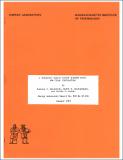A frequency domain finite element model for tidal circulation
Author(s)
Westerink, Joannes J.; Stolzenbach, Keith D.; Connor, J. J.
DownloadEL_TR_1985_006.pdf (7.986Mb)
Alternative title
Tidal circulation, A frequency domain finite element model
Other Contributors
Ralph M. Parsons Laboratory for Water Resources and Hydrodynamics.
Metadata
Show full item recordAbstract
A highly efficient finite element model has been developed for the numerical prediction of depth average circulation within small scale embayments which are often characterized by irregular boundaries and bottom topography. Traditional finite element models use time-stepping and have been plagued with requirements for high eddy viscosity coefficients and small time steps necessary to insure numerical stability, making application to small bays infeasible. These problems are overcome by operating in the frequency domain, an intrinsically more natural solution procedure for a highly periodic process such as tidal forcing. In order to handle non-linearities, an iterative scheme which updates non-linearities as right hand side force loadings must be implemented. Pioneering efforts with the harmonic approach have had shortcomings in either not modeling all physically relevant terms and/or in not gearing towards application to small scale regions. Small embayments are often quite shallow and have rapidly varying depth, making the nonlinear terms in the governing hydrodynamic equations much more significant. This requires that more frequencies be used in order to resolve the tide and account for the greater nonlinear coupling due to bottom friction, convective acceleration and finite amplitude effects. In order to make the process of handling this wide range of frequencies manageable, a hybrid frequency-time domain approach is applied. The iterative scheme revolves around a highly efficient linear core code which can handle a wide range of frequencies. Furthermore, instead of Fourier expanding the nonlinear terms, an efficient least squares error minimization algorithm is used for the discrete spectral analysis of the iteratively updated psuedo-force time history generated by the nonlinearities. With this highly efficient scheme it is now possible to efficiently study both short period and long term residual circulation within small scale embayments.
Date issued
1985Publisher
Cambridge, Mass. : Massachusetts Institute of Technology, Energy Laboratory and R.M. Parsons Laboratory for Water Resources and Hydrodynamics, Department of Civil Engineering, 1985
Series/Report no.
Energy Laboratory report (Massachusetts Institute of Technology. Energy Laboratory) no. MIT-EL 85-006.